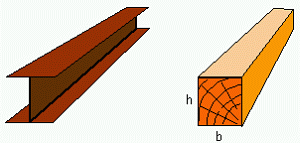
Figure 14: Steel beam and timber beam
When applying timber beams it should be noted that the traded dimensions my fall short by the width of the saw cut and by shrinkage from drying of up to 4 %. If in doubt, the dimensions should be measured. The section modules of steel beams should be taken from tables used in the steel trade.
The following figures are only for reference and used in chapter 6.
| dimensions in cm | 10 x 10 | 12 x 12 | 15 x 15 | 20 x 20 |
| section modulus in cm³ | 152 | 263 | 513 | 1217 |
Table 1: Section modules of timber beams (with 3 % shrinkage)
| dimensions in cm | 12 x 12 | 14 x 14 | 16 x 16 | 18 x 18 |
| section modulus in cm³ | 144 | 216 | 311 | 426 |
Table 2: Typical section modules of IPB steel beams
For the purpose of transport bedding, the permissible tensile stress of conifer timber may be appointed to 1 kN/cm², the same for mild steel to 15 kN/cm².
These figures already include safety margins that are required for vertical accelerations during sea transport, where it has been taken into account that the aforementioned extreme value of 1 g only scarcely occurs. Also the restricted duration of the sea transport justifies the mentioned figures.
The relation between maximum tensile stress σ, bending moment M and section modulus W reads:
Equation (9) shows, when using steel beams as bedding material, the section modulus may be smaller because the permissible tensile stress σ of steel is greater than that of timber by the factor 15.